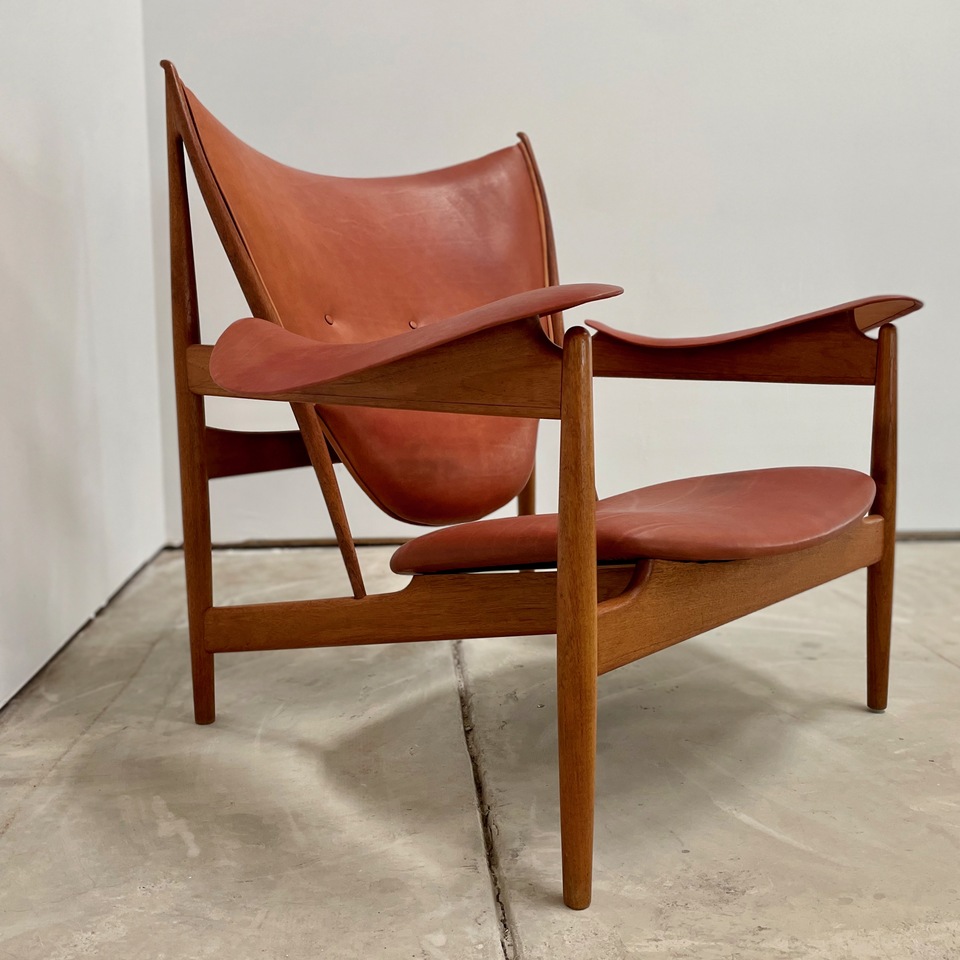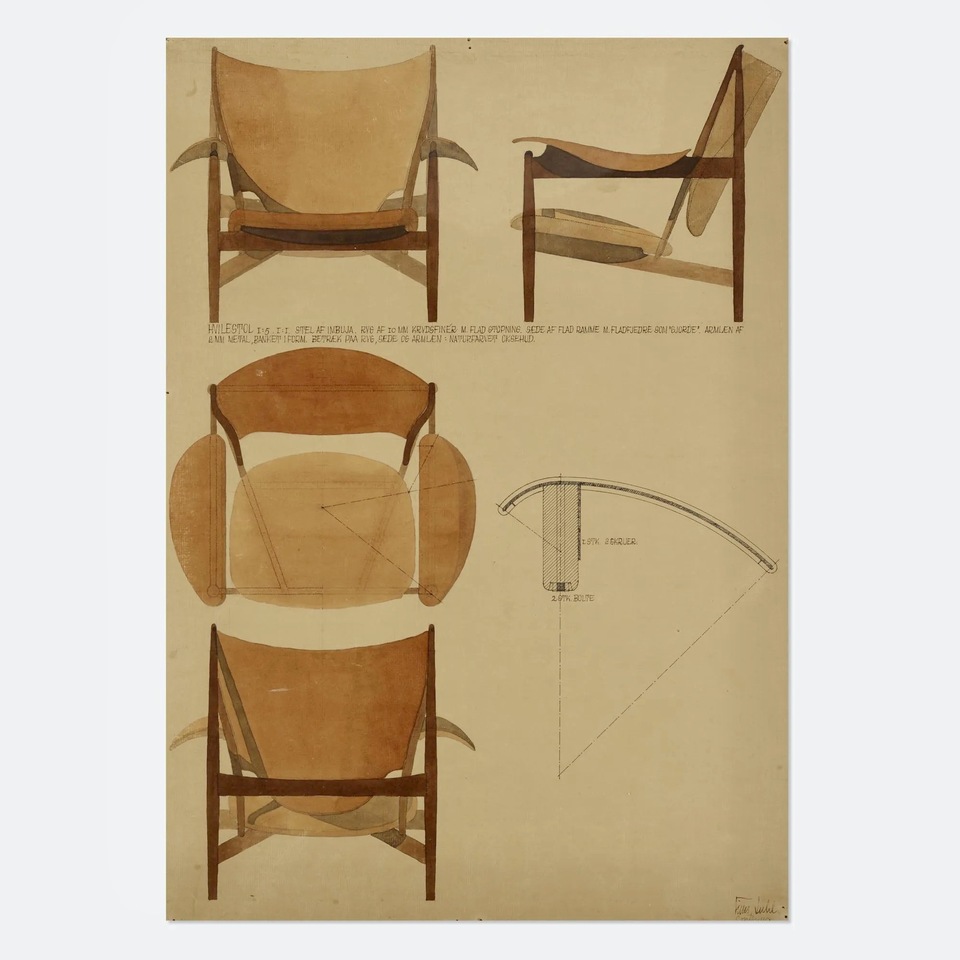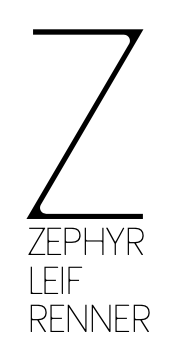
Finn Juhl Chieftain Chair by Niels Vodder
Finn Juhl's Chieftain chair has a poorly understood place in his work. In the mid and late 1940s he had designed forms like the FJ45 and FJ46 with sculptural and thin flap shaped armrests. He wanted to design a bigger chair and with a bigger armrest, but the limitations of wood were a challenge. He wanted the armrest to run the length of the arm and stretch outward like a thin and sculptural wing. He first attempt at this was a little known lounge chair from 1948 with a thick, slab-like wide armrest, supported by a strut underneath. It was not a success. In 1949 he again tried with Søren Willadsen to make an armchair, while smaller, but substantially similar to the Chieftain. It was first designed to have an undulating wide slab armrest with a metal diagonal support strut underneath, but again it was modified by the time of production to be a narrow armrest because stretching out like a wing still was not working.
So Finn took an entirely new approach, one without any precedent in a Danish cabinetmaker’s received learning. He made the armrest in hammered steel and covered it with cognac leather. The cognac color and natural grain of the leather complemented the teak wood frame, so while perhaps the viewer was not deceived that the armrest was teak minimizing the contrast between the teak and leather armrest. You can see in the original 1949 watercolor that Finn Juhl had a very different idea of how Niels Vodder would join the metal armrest to the wooden frame; there was a metal flange underneath the armrest, and to the best of my knowledge the chair was never made this way even at the Exhibition.
(As a footnote, Finn Juhl tried two more times, without success, to create his vision of a supersized sculptural wooden armrest. In 1951, his first attempt at the UN chair had such an armrest and to get sufficient width with economy another board was laminated on, but probably for economics and durability this concept was only made for the Guild Exhibition and an entirely different chair with normal scale armrests was designed for the UN, having moderate success for Baker and minimal success for Niels Vodder. In 1952 he designed a simple armchair for Niels Vodder, which ultimately became Søren Willadsen's SW86, returning to 1948’s idea of long and wide armrest with a wooden strut underneath. He drew this into a draft of his Trondheim Interior52 installation, but ultimately the Chieftain took that space in the exhibit. For the Søren Willadsen production the armrest was again thickened to slab like proportions and the slender dowel like support strut gained a tulip like shape to provide a wider load bearing area.)
Reading the text of the original watercolor, the Chieftain was to originally have a framed, sprung seat, which would have been the more cabinetmaker’s traditional way, but a bent plywood slab seat was opted for instead. This is an illustration of how Finn Juhl and Niels Vodder even as early as 1948 and 1949 were looking for ways to simplify production. While that is an obvious change, what is less obvious is how Finn Juhl’s aesthetic changed to support this. In fact the Chieftain involved much simpler sculpting of the wooden parts compared to his FJ46 armchair from three years earlier. The legs are a simple turning. The stretchers meet the legs with the simple angled joinery that does not require finishing to blend the two parts. Only the serpentine stiles and the horn required sculpting. It is an oversimplification to say it is a wooden wireframe with a backrest and seat artfully levitated within, but it is an illustrative statement. Or again, look at Rietveld’s famous chair and compare it to the Chieftain. There is something to the comparison!
Ironically the Chieftain was only moderately successful in cognac leather complementing the wood, which was originally either Teak, Imbuia, or Walnut. It gained much greater success around 1960 done in black leather which emphasized the wood and the contrast between the elements contrary to Finn Juhl’s original intent. The most iconic photos of the Chieftain in black leather were publicized by Illums Bolighus around 1960. (This very chair has surfaced today, even with original leather, currently owned by Dobrinka Salzman). Illums Bolighus was probably Niels Vodder’s first ever outside retailer and certainly the first of any importance. It was an important business relationship because the store did a good business with design tourists visiting Copenhagen. As Niels Vodder’s ties to the cabinetmakers’ collective display space, Den Permanente, was falling apart during the late 1950s, Illums Bolighus filled that gap.
Sometime around 1964-65 the original purchaser of this Chieftain visited Illums Bolighus and purchased a large amount of furniture. The short time period in the mid 1960s was notable in the evolution of the Chieftain design for a few subtle characteristics. The backrest and seat were upgraded to foam for greater comfort and depth of padding. Previously Illums’s Chieftain had been deeply padded in horsehair and these backrests had 4 buttons, like the very earliest 1949 version of the chair. The original watercolor suggests that Finn Juhl’s original preference for the backrest was buttonless, very much like the earlier FJ46 armchair. Theoretically this foam backrest might have allowed a buttonless back but it seems that either Finn Juhl had come to like 3 buttons or he felt the design needed continuity. Finn Juhl chose to try slightly longer horns for this revision. These are the longest horns you will see on a Niels Vodder Chieftain and the only longer ones are on the ultra rare almost unknown Baker Chieftain from 1954 (not the 1997 reissue).. Very quickly afterwards the horns were redesigned to have a backwards folded appearance, but for that brief span of time they were as you see them on this chair.
Designer: Finn Juhl
Maker: Niels Vodder
Model: FJ49a per the Niels Vodder catalog 1956
Design date: May, 1949
Made: circa 1964-1965
Original retailer: Illums Bolighus, Copenhagen
Price: on asking









